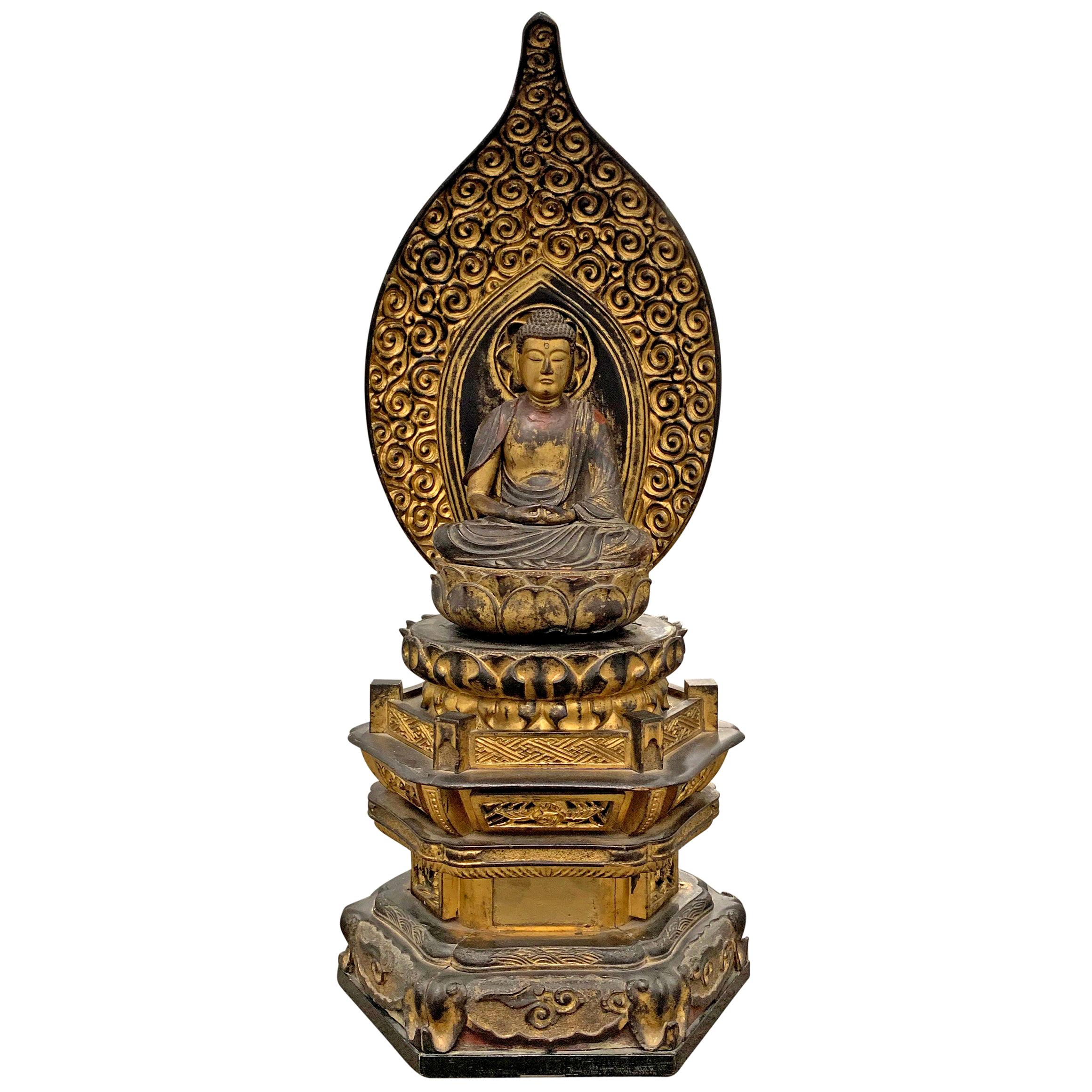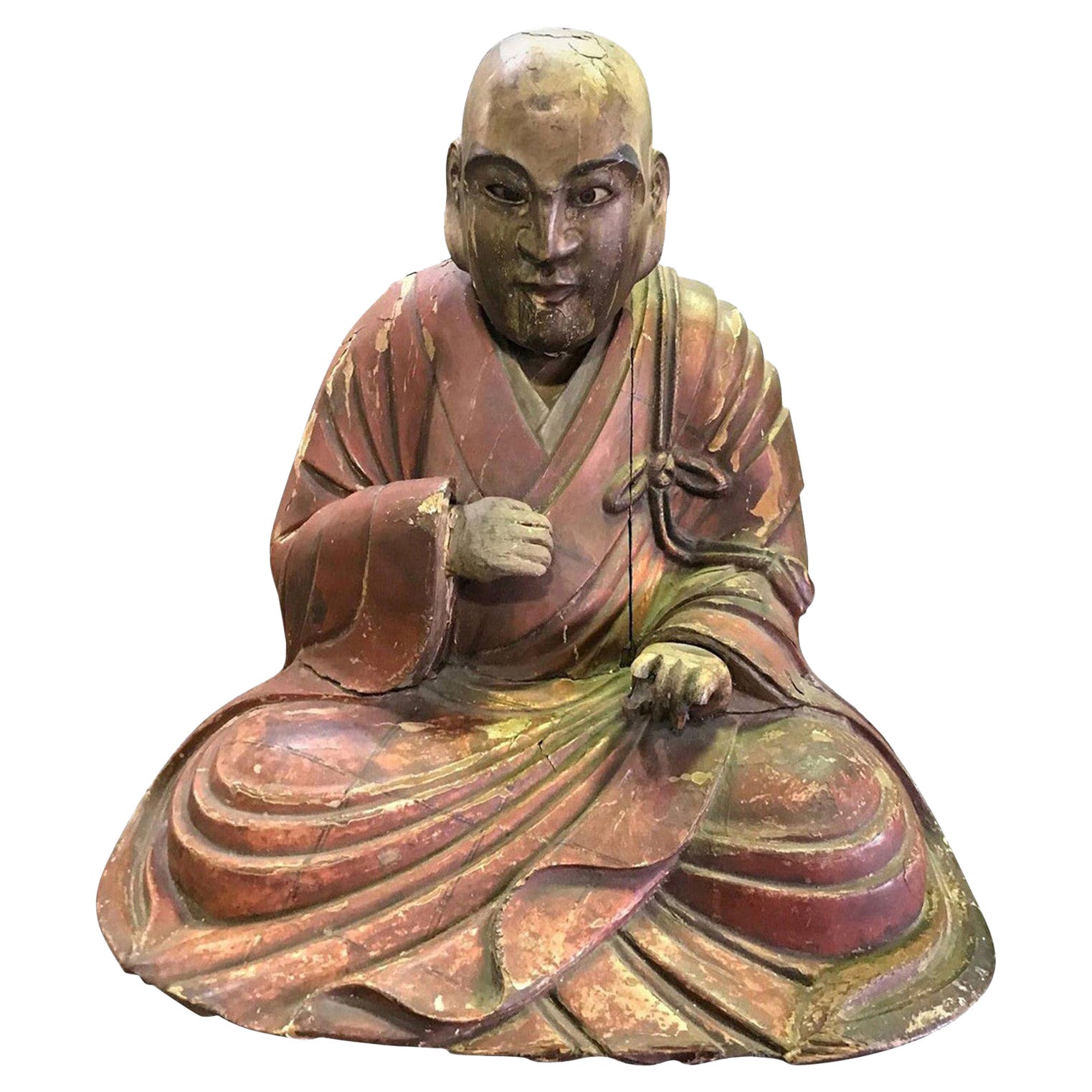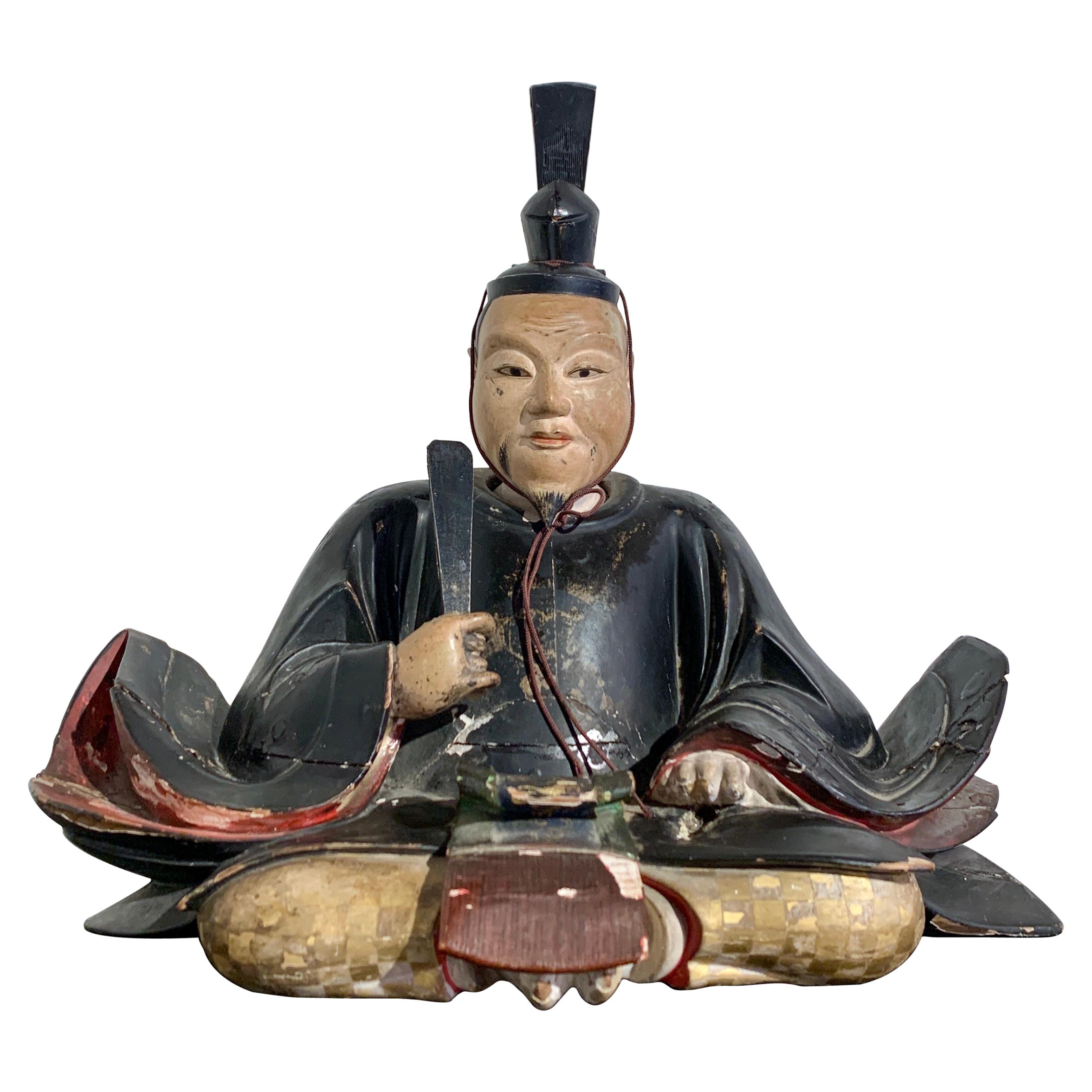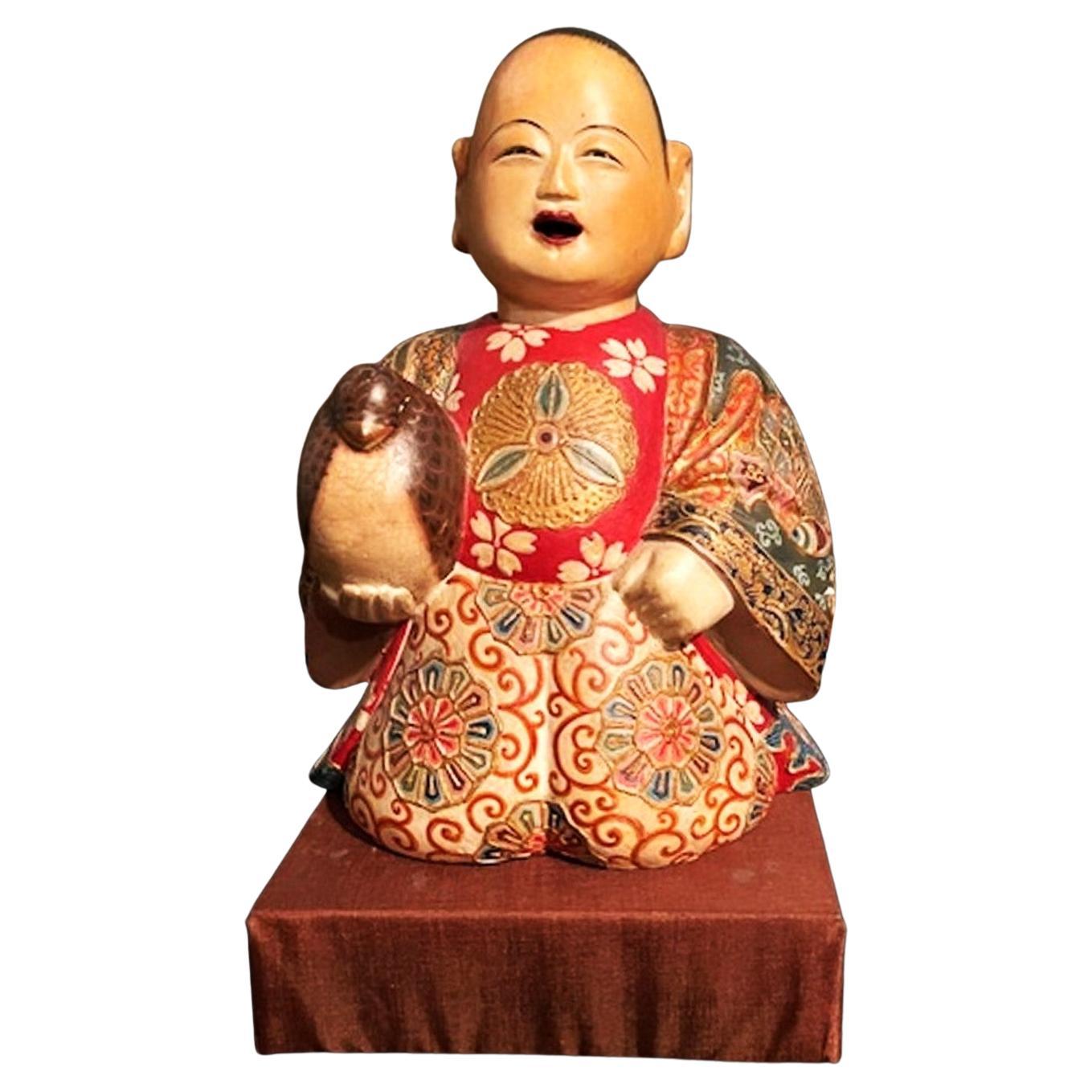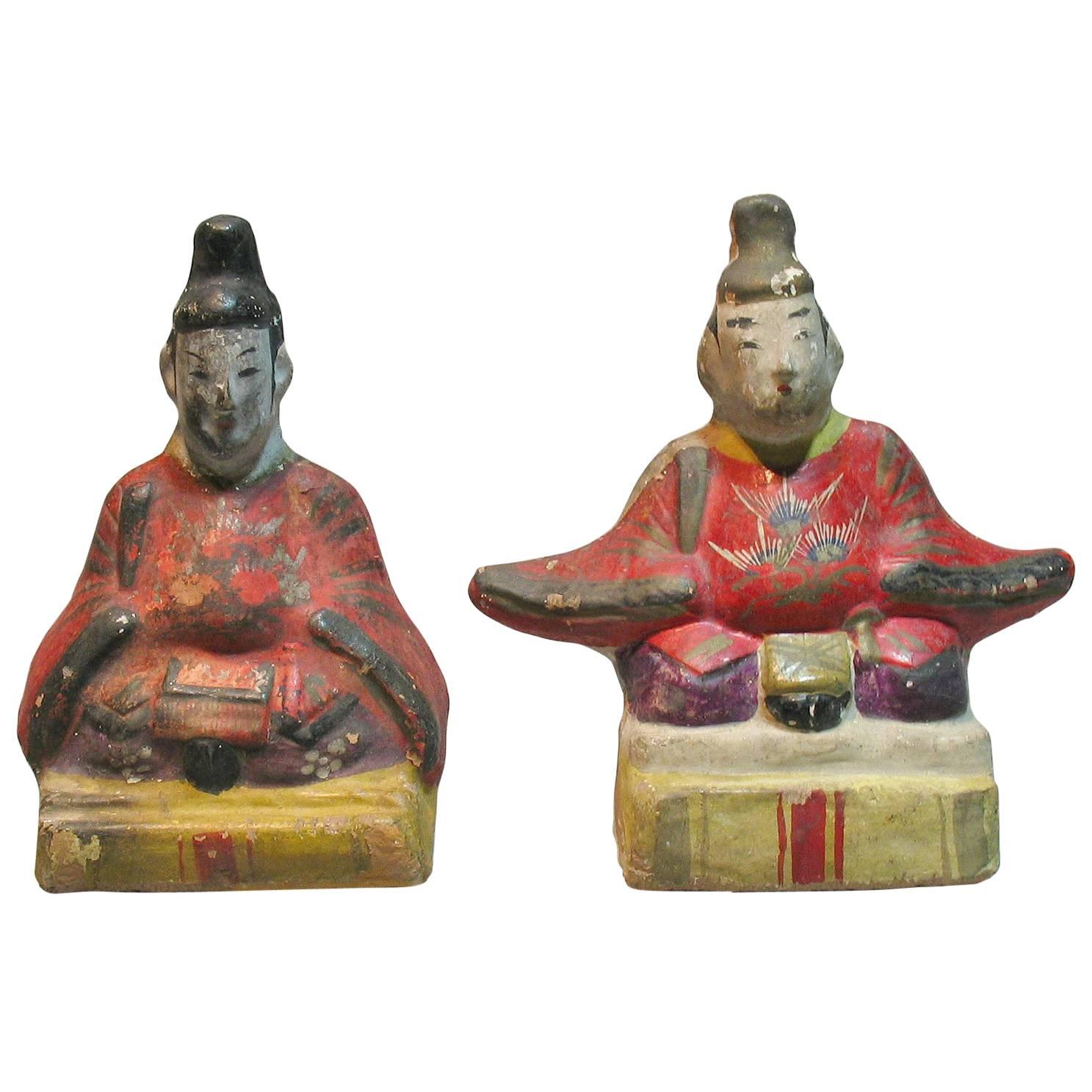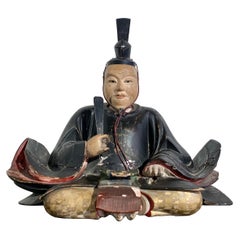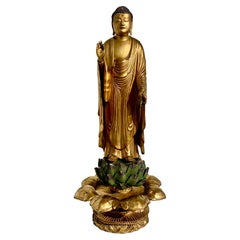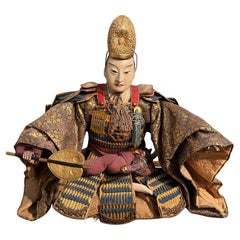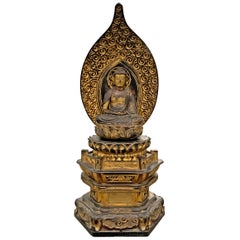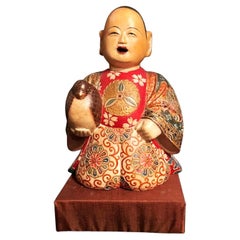Items Similar to Pair of Japanese Edo Period Musha Ningyo Courtier Dolls
Want more images or videos?
Request additional images or videos from the seller
1 of 10
Pair of Japanese Edo Period Musha Ningyo Courtier Dolls
About the Item
Two exquisite Japanese musha ningyo dolls, crafted as courtiers, Edo Period, early 19th century, Japan.
The older man can be identified as the historical figure Takenouchi no Sukune, a trusted court advisor to the warrior Empress Jingu and later, her son Ojin. He is always portrayed as an elderly man with a gaunt face and long white beard and mustache. He kneels on one knee, and is dressed ins simple black robes, with a simple black lacquer eboshi, in stark contrast to his younger companion, who sits in a more typical court fashion, and wears much richer brocaded robes, and a gilt lacquer eboshi.
Made for Boys' Day celebrations, these two dolls embody ideals of masculine virtues that young boys are supposed to strive towards. In this case, the values of piety, loyalty, grace, beauty, culture and refinement, among others, are on clear display.
Crafted in typical ningyo fashion of carved wood, the faces, hands and feet covered in gofun (crushed oyster shell paste), and dressed in silk robes, with silk for hair. The faces of both with inset glass eyes for added realism.
- Dimensions:Height: 14.5 in (36.83 cm)Width: 17 in (43.18 cm)Depth: 10 in (25.4 cm)
- Sold As:Set of 2
- Style:Edo (Of the Period)
- Materials and Techniques:
- Place of Origin:
- Period:
- Date of Manufacture:Early 19th Century
- Condition:Wear consistent with age and use. Minor losses. Minor fading. Shattering to the silk robes of Takenouchi. Minor flaking to the gofun to both dolls. The younger doll missing one lappet to the costume. Please see photos.
- Seller Location:Austin, TX
- Reference Number:1stDibs: LU89475208013
About the Seller
5.0
Vetted Professional Seller
Every seller passes strict standards for authenticity and reliability
Established in 2001
1stDibs seller since 2010
338 sales on 1stDibs
Typical response time: 1 hour
- ShippingRetrieving quote...Shipping from: Austin, TX
- Return Policy
Authenticity Guarantee
In the unlikely event there’s an issue with an item’s authenticity, contact us within 1 year for a full refund. DetailsMoney-Back Guarantee
If your item is not as described, is damaged in transit, or does not arrive, contact us within 7 days for a full refund. Details24-Hour Cancellation
You have a 24-hour grace period in which to reconsider your purchase, with no questions asked.Vetted Professional Sellers
Our world-class sellers must adhere to strict standards for service and quality, maintaining the integrity of our listings.Price-Match Guarantee
If you find that a seller listed the same item for a lower price elsewhere, we’ll match it.Trusted Global Delivery
Our best-in-class carrier network provides specialized shipping options worldwide, including custom delivery.More From This Seller
View AllJapanese Carved and Lacquered Wood Shogun, Edo Period, 19th Century, Japan
Located in Austin, TX
An unusual Japanese carved wood, lacquer, and gilt decorated portrait sculpture of a shogun, Edo Period, early 19th century, Japan.
The unidentified shogun (possibly Tokugawa Iey...
Category
Antique Mid-19th Century Japanese Edo Sculptures and Carvings
Materials
Wood, Lacquer
Pair of Japanese Gilt Bronze Komainu by Ishikawa Komei, Meiji Period
Located in Austin, TX
A striking pair of Japanese gilt bronze komainu by the renowned Japanese sculptor, Ishikawa Komei (1852-1913), Meiji period, Japan.
The pair well cast, and robustly modeled. They ar...
Category
Antique Late 19th Century Japanese Meiji Sculptures and Carvings
Materials
Bronze
Japanese Lacquered Wood Sho Kannon, Momoyama/Edo Period, 17th Century, Japan
Located in Austin, TX
A tall and impressive Japanese carved and black lacquered figure of Sho Kannon Bosatsu, Momoyama or Edo Period, mid 17th century, on a later mid 19th century carved, painted, and gilt wood lotus...
Category
Antique Mid-17th Century Japanese Edo Sculptures and Carvings
Materials
Metal
Japanese Standing Gilt Buddha, Amida Nyorai, Edo Period, 18th century, Japan
Located in Austin, TX
An exquisite Japanese carved hinoki and gilt lacquered standing figure of Amida Nyorai, Amitabha Buddha, Edo Period, 18th century, Japan.
The spectacular fully gold gilt figure of A...
Category
Antique 18th Century Japanese Edo Sculptures and Carvings
Materials
Rock Crystal
Japanese Buddhist Mirror and Dragon Stand, Edo Period, early 19th c, Japan
Located in Austin, TX
A powerful and rare Japanese Buddhist "sacred" mirror and stand, Edo Period, late 18th or early 19th century, Japan.
The bronze mirror is housed in a two part gilt wood and lacquer ...
Category
Antique Early 19th Century Japanese Edo Sculptures and Carvings
Materials
Bronze
Japanese Giltwood Medicine Buddha, Yakushi Nyorai, Muromachi Period 16th Century
Located in Austin, TX
A striking Japanese late Muromachi Period (1333-1573) lacquered and giltwood figure of Yakushi Nyorai, the Medicine Buddha, seated upon an elaborate car...
Category
Antique 16th Century Japanese Edo Sculptures and Carvings
Materials
Rock Crystal
You May Also Like
Japanese Edo Period Musha Ningyo Seating Samurai, Ca. 1800
Located in New York, NY
Japanese Edo Period Musha Ningyo Seating Samurai, Ca. 1800
DIMENSIONS
Height: 16 inches
Width: 19 inches
Depth: 10 inches
ABOUT
Musha Ningyō (武者人形)- Literal meaning: "Warrior Dolls...
Category
Antique Early 1800s Japanese Japonisme Figurative Sculptures
Materials
Wood
Edo Period Japanese Bodhisattva Shrine
Located in Chicago, IL
An incredible Edo Period Japanese gilt and lacquered carved wood shrine depicting a Bodhisattva with piercing glass eyes, a contemplative expression, and h...
Category
Antique Early 1800s Japanese Japonisme Sculptures and Carvings
Materials
Giltwood, Lacquer, Wood
Japanese Wood Carved Polychrome Sculpture of a Seated Temple Monk, Edo Period
Located in Studio City, CA
This is truly a wonderful piece with clear age and a nice patina to it. Very unique. We have not seen another quite like it. The monk appears to have glass eyes which gives his expression a very humanistic feel. The head is removable (please see the last image).
From a collection of Japanese arts and artifacts. Most likely dates back to the Edo period.
Would make for a nice addition to any Japanese or Asian artifacts...
Category
Antique 18th Century Japanese Edo Sculptures and Carvings
Materials
Wood, Lacquer
Japanese Edo Period Saga Ningyo, Ca. 1850
Located in New York, NY
Japanese Edo Period Saga Ningyo, Ca. 1850
DIMENSIONS
Height: 9.5 inches
Width: 6 inches
Depth: 5 inches
Category
Antique 1850s Japanese Japonisme Figurative Sculptures
Materials
Wood
Two Rare Japanese Izumo Clay Dolls of Emperor and Tenjin, Meiji Period
Located in Ottawa, Ontario
Two rare Japanese Izumo clay dolls of Emperor and Tenjin, Nara Prefecture, Meiji period. Material and simple execution impart a flavor of antiquity and great decorative power. Empero...
Category
Antique Late 19th Century Japanese Meiji Sculptures and Carvings
Materials
Clay
Japanese Lacquered and Gilt Wood Buddhism Statue from Edo Period
Located in Atlanta, GA
An exceptional and wood statue of Buddhism Guardian Seitaka Doji from Japan circa Edo period (1603-1868), likely the earlier part of 17th century. One of two chief attendants of Fudou Myouou (the other being Kongara Doji), the name of Seitaka Doji is a transliteration of Sanskrit "Cetaka", meaning servant, slave, and he is said to personify expedient action. He is most commonly found on the right side of Fudou, together with Kongara Doji on the left, forming the Immovable triad, Fudou Sanzon, the terror of evil doers. Seitaka largely adheres to the iconography of a wrathful youth with fleshy body and face, skin in the color of a red lotus, has his hair tied in five knots, and holds a vajra in his left hand and a vajra-club in his right hand, but the actual artistic representations of him in Japan do...
Category
Antique 17th Century Japanese Japonisme Sculptures and Carvings
Materials
Metal
Recently Viewed
View AllMore Ways To Browse
Fashion Doll
Oyster Shell
Used Oyster Shells
Old Dolls
Black Silk Brocade
Used Glass Crusher
19th Century Shell Sculpture
Japanese Silk Dress
Wood Kneelers
Long Silk Brocade
Carved Wood Doll
Doll Display
Black Brocade Dress
Black Silk Robe
Antique Black Dolls
Antique Paper Dolls
Antique Doll Dress
Antique Glass Dolls

